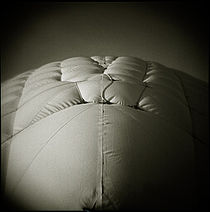
Vignetting
Encyclopedia


Photography
Photography is the art, science and practice of creating durable images by recording light or other electromagnetic radiation, either electronically by means of an image sensor or chemically by means of a light-sensitive material such as photographic film...
and optics
Optics
Optics is the branch of physics which involves the behavior and properties of light, including its interactions with matter and the construction of instruments that use or detect it. Optics usually describes the behavior of visible, ultraviolet, and infrared light...
, vignetting (icon; French: "vignette") is a reduction of an image's brightness
Brightness
Brightness is an attribute of visual perception in which a source appears to be radiating or reflecting light. In other words, brightness is the perception elicited by the luminance of a visual target...
or saturation
Saturation
Saturation or saturated may refer to:- Meteorology :* Dew point, which is a temperature that occurs when atmospheric humidity reaches 100% and the air is saturated with moisture- Physics :...
at the periphery compared to the image center. The word vignette, from the same root as vine
Vine
A vine in the narrowest sense is the grapevine , but more generally it can refer to any plant with a growth habit of trailing or scandent, that is to say climbing, stems or runners...
, originally referred to a decorative border in a book. Later, the word came to be used for a photographic portrait which is clear in the center, and fades off at the edges. A similar effect occurs when filming projected images or movies off a projection screen. The resulting so-called "hotspot" effect defines a cheap home-movie look where no proper telecine
Telecine
Telecine is transferring motion picture film into video and is performed in a color suite. The term is also used to refer to the equipment used in the post-production process....
is used.
Vignetting is often an unintended and undesired effect caused by camera settings or lens limitations. However, it is sometimes purposely introduced for creative effect, such as to draw attention to the center of the frame. A photographer may deliberately choose a lens which is known to produce vignetting to obtain the effect, or it may be introduced with the use of special filters or post-processing
Image processing
In electrical engineering and computer science, image processing is any form of signal processing for which the input is an image, such as a photograph or video frame; the output of image processing may be either an image or, a set of characteristics or parameters related to the image...
procedures.
Causes
There are several causes of vignetting. Sidney F. Ray distinguishes the following types:- Mechanical vignetting
- Optical vignetting
- Natural vignetting
A fourth cause is unique to digital imaging:
- Pixel vignetting
A fifth cause is unique to analog imaging:
- Photographic film vignetting
Mechanical vignetting
Mechanical vignetting occurs when light beams emanating from object points located off-axis are partially blocked by external objects such as thick or stacked filters, secondary lenses, and improper lens hoods. This has the effect of changing the entrance pupilEntrance pupil
In an optical system, the entrance pupil is the optical image of the physical aperture stop, as 'seen' through the front of the lens system. The corresponding image of the aperture as seen through the back of the lens system is called the exit pupil...
shape as a function of angle. The darkening can be gradual or abrupt, depending on the lens aperture
Aperture
In optics, an aperture is a hole or an opening through which light travels. More specifically, the aperture of an optical system is the opening that determines the cone angle of a bundle of rays that come to a focus in the image plane. The aperture determines how collimated the admitted rays are,...
. The smaller the aperture, the more abrupt the vignetting as a function of angle. Complete blackening is possible with mechanical vignetting (when the corner of the image is essentially imaging the inside of the lens hood or filter holder).
Optical vignetting
This type of vignetting is caused by the physical dimensions of a multiple element lens. Rear elements are shaded by elements in front of them, which reduces the effective lens opening for off-axis incident light. The result is a gradual decrease in light intensity towards the image periphery. Optical vignetting is sensitive to the lens apertureAperture
In optics, an aperture is a hole or an opening through which light travels. More specifically, the aperture of an optical system is the opening that determines the cone angle of a bundle of rays that come to a focus in the image plane. The aperture determines how collimated the admitted rays are,...
and can be completely cured by a reduction in aperture of 2–3 stops. (An increase in the F-number
F-number
In optics, the f-number of an optical system expresses the diameter of the entrance pupil in terms of the focal length of the lens; in simpler terms, the f-number is the focal length divided by the "effective" aperture diameter...
.)
Natural vignetting
Unlike the previous types, natural vignetting (also known as natural illumination falloff) is not due to the blocking of light rays. The falloff is approximated by the cos4 or "cosine fourth" law of illumination falloff. Here, the light falloff is proportional to the fourth power of the cosine of the angle at which the light impinges on the film or sensor array. Wideangle rangefinder designs and the lens designs used in compact cameras are particularly prone to natural vignetting. Telephoto lenses, retrofocusAngenieux retrofocus
The Angénieux retrofocus photographic lens is a wide-angle lens design that uses an inverted telephoto configuration. The popularity of this lens design made the name retrofocus synonymous with this type of lens...
wideangle lenses used on SLR
Single-lens reflex camera
A single-lens reflex camera is a camera that typically uses a semi-automatic moving mirror system that permits the photographer to see exactly what will be captured by the film or digital imaging system, as opposed to pre-SLR cameras where the view through the viewfinder could be significantly...
cameras, and telecentric
Telecentric lens
A telecentric lens is a compound lens which has its entrance or exit pupil at infinity; in the prior case, this produces an orthographic view of the subject. This means that the chief rays are parallel to the optical axis in front of or behind the system, respectively...
designs in general are less troubled by natural vignetting. A gradual grey filter or postprocessing techniques may be used to compensate for natural vignetting, as it cannot be cured by stopping down the lens. Some modern lenses are specifically designed so that the light strikes the image parallel or nearly so, eliminating or greatly reducing vignetting. Almost all lenses designed for the Four Thirds system
Four Thirds System
The Four Thirds system is a standard created by Olympus and Kodak for digital single-lens reflex camera design and development.The system provides a standard that, with digital cameras and lenses available from multiple manufacturers, allows for the interchange of lenses and bodies from different...
are of this type, as telecentricity is a stated design goal.
Pixel vignetting
Pixel vignetting only affects digital cameras and is caused by angle-dependence of the digital sensors. Light incident on the sensor at a right angle produces a stronger signal than light hitting it at an oblique angle. Most digital cameras use built-in image processing to compensate for optical vignetting and pixel vignetting when converting raw sensor data to standard image formats such as JPEGJPEG
In computing, JPEG . The degree of compression can be adjusted, allowing a selectable tradeoff between storage size and image quality. JPEG typically achieves 10:1 compression with little perceptible loss in image quality....
or TIFF. The use of offset microlens
Microlens
A microlens is a small lens, generally with a diameter less than a millimetre and often as small as 10 micrometres . The small sizes of the lenses means that a simple design can give good optical quality but sometimes unwanted effects arise due to optical diffraction at the small features...
es over the image sensor can also reduce the effect of pixel vignetting.


Post-shoot
For artistic effect, vignetting is sometimes applied to an otherwise un-vignetted photograph and can be achieved by burning the outer edges of the photograph (with film stock) or using digital imaging techniques, such as masking darkened edges. The Lens Correction filter in Photoshop can also achieve the same effect.In digital imaging, this technique is used to create a lo-fi appearance in the picture.
See also
- Flat-field correctionFlat-field correctionthumb|210px|The brightness variation due to [[vignetting]], as shown here, can be corrected by selectively brightening the perimeter of the image.Flat-field correction is a technique used to improve quality in digital imaging...
- Dodging and burning

